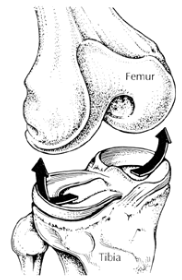Meniscal Injuries
The meniscus acts as a shock-absorber or cushion inside the knee.
 As we age and remain active, the menisci can often get injured or damaged with time. Many factors contribute to this, but genetics, a past history of injury or surgery, and trauma seem to be the most important causes.
As we age and remain active, the menisci can often get injured or damaged with time. Many factors contribute to this, but genetics, a past history of injury or surgery, and trauma seem to be the most important causes.
The meniscus is located between the femur (thigh bone) and the tibia (shin bone). There are two menisci in the knee, the medial meniscus (inside of the knee) and the lateral meniscus (outside of the knee). The menisci are made of fibrocartilage, a special type of cartilage. They function as shock absorbers and force distributors that help to stabilize the knee.
Meniscal tears can present with pain to the knee as well as symptoms of clicking, catching and locking. Because of the poor blood supply to the meniscus, the majority of meniscal tears are unable to heal on their own.
Treatment
 Meniscal tears rarely are able to heal themselves; however, this does not mean that they need to be treated surgically. The main focus of nonoperative treatment is to reduce the inflammation that commonly results from the meniscal tear. Through treatments such as rest, anti-inflammatory medications, injections, and physical therapy, the inflammation can be reduced and thus resolve the pain to the knee. Although the meniscal tear does not heal, it often can become asymptomatic in many individuals once the inflammation has resolved.
Meniscal tears rarely are able to heal themselves; however, this does not mean that they need to be treated surgically. The main focus of nonoperative treatment is to reduce the inflammation that commonly results from the meniscal tear. Through treatments such as rest, anti-inflammatory medications, injections, and physical therapy, the inflammation can be reduced and thus resolve the pain to the knee. Although the meniscal tear does not heal, it often can become asymptomatic in many individuals once the inflammation has resolved.
In patients who continue to have pain and symptoms despite conservative treatments, surgery interventions such as a partial meniscectomy (excision) can be performed. This is an outpatient surgery with an arthroscope (a camera used to look into the joint) and two or three small incisions around the knee to look and work inside. In rare cases and depending on the location of the tear, a meniscal repair can also be performed arthroscopically.
